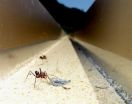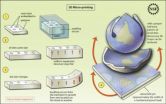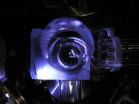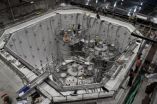(Press-News.org) Desert ants have adapted to a life in a barren environment which only provides very few landmarks for orientation. Apart from visual cues and odors the ants use the polarized sunlight as a compass and count their steps in order to return safely to their home after searching for food. In experiments with ants of the genus Cataglyphis in their natural habitats in Tunisia and Turkey, behavioral scientists of the Max Planck Institute for Chemical Ecology in Jena, Germany, have now discovered that ants can also use magnetic and vibrational landmarks in order to find their way back to their nest − a small hole in the desert ground. In addition, carbon dioxide produced by their nestmates' breathing also helps homing ants to pinpoint their nest entrance. Hence, the ants' navigational skills prove enormously adaptable to their inhospitable environment. (PLoS ONE, March 7, 2012; Current Biology, March 8, 2012)
Returning to the wrong nest can be lethal
Path integration is a fascinating mechanism that ants use for orientation. It combines counting the steps after leaving the nest with determining the direction by using polarized sunlight. This method, which helps the insects to return to their nest, is an important survival formula in the barren environments of deserts. However, the path integrator is error-prone. Therefore ants also use landmarks in order to find home quickly and unerringly: Visual as well as olfactory landmarks serve as important cues. For ants, it is a question of life and death to find the right nest because they may be killed or at least attacked by resident ants if they enter the wrong nest accidentally.
Vibration or magnetism
It is known from leaf-cutting ants that they use vibrational signals for communication. That ants − like birds − also sense the earth's magnetic field, becomes more and more likely. Therefore, the researchers in Markus Knaden's lab, behavioral scientists in the Department of Bill Hansson at the Max Planck Institute for Chemical Ecology, wanted to find out whether desert ants − adapted to landscapes providing a minimum of cues − are able to use magnetism and vibrational signals in the absence of other landmarks. "We were very surprised that this is actually the case," says PhD student Cornelia Buehlmann, who performed the experiments. Trained ants of the species Cataglyphis noda pinpointed their nest without any problem if a battery-powered vibrational device was buried next to the nest entrance so that the ants could localize their nest by using the vibrational landmark. To exclude electromagnetic effects of the device, experiments were performed using the vibrational device without contact to the ground. The result: The ants behaved like their untrained conspecifics. They wandered around aimlessly. If two strong neodym magnets generating a magnetic field of about 21 millitesla (the earth's magnetic field was, for comparison, only 0.041 millitesla) were placed above ground next to the nest, trained ants again found their home without any problems.
The experiments demonstrated the desert ants' highly sensitive reaction to vibrational signals. However, it is unknown which sense is involved in the orientation using the artificial magnetic field around the nest. "This doesn't mean that ants have a kind of sensory organ for the detection of magnetic fields. Their behavior could also be caused by abnormal neural electrical signals due to the strong magnetic field which were memorized by the ants," says Knaden. Anyhow, neither vibrations nor strong magnetic fields are likely present in the natural vicinity of nest entrances. Therefore it is really astonishing that ants "remember" vibrations or a changing magnetic field as nest landmarks. Ants which have adapted to extremely inhospitable habitats seem to be remarkably flexible in terms of using all senses for navigation.
VIDEO:
Sequences of the movie: i.) Set up of an experiment in the desert (Tunisia), ii.) thread and smoke visualize the direction of the nest plume, iii.) an ant moving straight...
Click here for more information.
CO2 as an olfactory landmark
Carbon dioxide produced by the ants' breathing is an olfactory signal that is constantly present at the nest entrances. That desert ants of the species Cataglyphis fortis use the CO2 plume in order to return to their home could now be shown by experiments performed in Tunisia. The ants ran upwind along the nest plume when the CO2 concentration was not too high and corresponded with the typical plume concentration in the nest vicinity. However, CO2 is released by all the nests and therefore all nests smell the same. Therefore the question is: How can ants recognize their own nest when all smell like home? "We could show in a series of experiments that ants primarily rely on path integration," explains Cornelia Buehlmann. If ants were released in the close vicinity of their own nest by hand after they had walked to a feeding place, they avoided following the original nest plume of their own nest: The olfactory signal and the number of footsteps did not coincide. In order not to lose their lives in a foreign nest, ants trust path integration more than the chemical signal CO2. They only follow the nest plume when path integration tells them that they are close to home. [JWK/AO]
INFORMATION:
Original Publications:
Cornelia Buehlmann, Bill S. Hansson, Markus Knaden: Desert ants learn vibration and magnetic landmarks. PLoS ONE 7(3): e33117. DOI:10.1371/journal.pone.0033117
Cornelia Buehlmann, Bill S. Hansson, Markus Knaden: Path integration controls nest-plume following in desert ants. Current Biology, Online First, March 8, 2012; DOI: 10.1016/j.cub.2012.02.029
Further Reading:
Steck, Kathrin: Just follow your nose: homing by olfactory cues in ants. Current Opinion in Neurobiology (2011), DOI:10.1016/j.conb.2011.10.011
Further Information:
Dr. Markus Knaden, +49 3641 57 1421, mknaden@ice.mpg.de
Picture Material:
Angela Overmeyer M.A., Tel. 03641 - 57 2110, overmeyer@ice.mpg.de
or Download via www.ice.mpg.de/ext/735.html
Orientation of desert ants: Every cue counts
Foraging desert ants always find their way back to the nest, even when it is only marked by a magnetic cue, vibration, or carbon dioxide
2012-03-12
ELSE PRESS RELEASES FROM THIS DATE:
Researchers 'print' polymers that bend into 3-D shapes
2012-03-12
Christian Santangelo, Ryan Hayward and colleagues at the University of Massachusetts Amherst recently employed photographic techniques and polymer science to develop a new technique for printing two-dimensional sheets of polymers that can fold into three-dimensional shapes when water is added. The technique may lead to wide ranging practical applications from medicine to robotics
The journal Science publishes the research in its March 9 issue.
Researchers used a photomask and ultraviolet (UV) light to "print" a pattern onto a sheet of polymers, a technique called photolithography. ...
Genetic marker for painful food allergy points to improved diagnosis, treatment
2012-03-12
Researchers have identified a genetic signature for a severe, often painful food allergy – eosinophilic esophagitis – that could lead to improved diagnosis and treatment for children unable to eat a wide variety of foods.
The scientists, from Cincinnati Children's Hospital Medical Center, report in the Journal of Allergy and Clinical Immunology that they have pinpointed a dysregulated microRNA signature for eosinophilic esophagitis (EoE), a disease that also may cause weight loss, vomiting, heartburn and swallowing difficulties.
Interestingly, the dysregulated microRNA ...
New 'pendulum' for the ytterbium clock
2012-03-12
The faster a clock ticks, the more precise it can be. Due to the fact that lightwaves vibrate faster than microwaves, optical clocks can be more precise than the caesium atomic clocks which presently determine time. The Physikalisch-Technische Bundesanstalt (PTB) is even working on several of such optical clocks simultaneously. The model with one single ytterbium ion caught in an ion trap is now experiencing another increase in accuracy. At PTB, scientists have succeeded in exciting a quantum-mechanically strongly "forbidden" transition of this ion and – in particular – ...
Iridescent, feathered dinosaur: New evidence that feathers evolved to attract mates
2012-03-12
The detailed feather pattern and color of Microraptor--a pigeon-sized, four-winged dinosaur that lived about 120 million years ago--had a glossy iridescent sheen.
Its tail was narrow and adorned with a pair of streamer feathers, suggesting the importance of display in the early evolution of feathers, say scientists reporting the findings in this week's issue of the journal Science.
By comparing the patterns of pigment-containing organelles from a Microraptor fossil to those in modern birds, the scientists determined that the dinosaur's plumage was iridescent with a ...
NOHO Dental Group Now Offers Several Special Promotions for New and Existing Patients
2012-03-12
NOHO Dental Group and Dr. Afar, North Hollywood dentist, are offering a variety of specials for new and existing patients. For a short time, patients can receive discounts on a wide number of dental procedures, allowing both new patients and those who have been with the NOHO Dental Group for years to save money and try new dental services.
These specials include a wide variety of services, such as a $49 dental exam with x-rays for new patients. For patients who need preventative care like dental cleanings, this special allows new patients to try out the services of Dr. ...
NIH study links childhood cancer to developmental delays in milestones
2012-03-12
Infants and toddlers who have been treated for cancer tend to reach certain developmental milestones later than do their healthy peers, say researchers at the National Institutes of Health and in Italy.
The findings show that delays may occur early in the course of treatment and suggest that young children with cancer might benefit from such early interventions as physical or language therapy.
Compared to children who had not had cancer, children treated for cancer before age 4 progressed more slowly in vocabulary, cognitive functions such as attention and memory, and ...
Cultural differences may impact neurologic and psychiatric rehabilitation of Spanish speakers
2012-03-12
Amsterdam, NL, 9 March 2012 – The number of people with neurological and psychiatric disorders in Spanish-speaking countries has increased over the past two decades. The February issue of NeuroRehabilitation assesses important factors that should be considered in rehabilitating Spanish-speaking individuals suffering from these disorders.
"Though much work has been done in this area for Anglo-Saxon populations, very little work has focused on Spanish-speaking individuals," says Guest Editor Juan Carlos Arango-Lasprilla, PhD, of the Department of Physical Medicine and ...
In recognizing faces, the whole is not greater than the sum of its parts
2012-03-12
How do we recognize a face? To date, most research has answered "holistically": We look at all the features—eyes, nose, mouth—simultaneously and, perceiving the relationships among them, gain an advantage over taking in each feature individually. Now a new study overturns this theory. The researchers—Jason M. Gold and Patrick J. Mundy of the Indiana University and Bosco S. Tjan of the University of California Los Angeles—found that people's performance in recognizing a whole face is no better than their performance with each individual feature shown alone. "Surprisingly, ...
A big discovery in the study of neutrinos, tiny particles that have a big role in the universe
2012-03-12
An international team of physicists has determined a key parameter, which governs how neutrinos behave. This discovery measures a critical linchpin in the study of the tiny particles and in advancing the understanding of how these building blocks of all things, from galaxies to tea cups, came to be.
The Daya Bay Reactor Neutrino Experiment, a multinational collaboration including a team from Virginia Tech, discovered a new type of neutrino oscillation in which the particles appear to vanish as they travel. The researchers found that the rate of oscillations was much larger ...
Wilshire Dental Care Now Offers Sedation Dentistry Options
2012-03-12
Dr. Afar, Los Angeles dentist at Wilshire Dental Care, is offering a variety of sedation dentistry techniques to make patient's experiences relaxing and pain-free. Sedation dentistry is the use of various techniques to reduce stress and pain during a dental procedure. Dr. Afar offers various types of sedation dentistry techniques to meet a variety of patient needs.
Oral sedation is the use of oral medications such as pills and liquids and is used when patients require only a small degree of sedation, and for procedures like dental crown preparation or fillings that do ...
LAST 30 PRESS RELEASES:
The Ceramic Society of Japan’s Oxoate Ceramics Research Association launches new international book project
Heart-brain connection: international study reveals the role of the vagus nerve in keeping the heart young
Researchers identify Rb1 as a predictive biomarker for a new therapeutic strategy in some breast cancers
Survey reveals ethical gaps slowing AI adoption in pediatric surgery
Stimulant ADHD medications work differently than thought
AI overestimates how smart people are, according to HSE economists
HSE researchers create genome-wide map of quadruplexes
Scientists boost cell "powerhouses" to burn more calories
Automatic label checking: The missing step in making reliable medical AI
Low daily alcohol intake linked to 50% heightened mouth cancer risk in India
American Meteorological Society announces Rick Spinrad as 2026 President-Elect
Biomass-based carbon capture spotlighted in newly released global climate webinar recording
Illuminating invisible nano pollutants: advanced bioimaging tracks the full journey of emerging nanoscale contaminants in living systems
How does age affect recovery from spinal cord injury?
Novel AI tool offers prognosis for patients with head and neck cancer
Fathers’ microplastic exposure tied to their children’s metabolic problems
Research validates laboratory model for studying high-grade serous ovarian cancer
SIR 2026 delivers transformative breakthroughs in minimally invasive medicine to improve patient care
Stem Cell Reports most downloaded papers of 2025 highlight the breadth and impact of stem cell research
Oxford-led study estimates NHS spends around 3% of its primary and secondary care budget on the health impacts of heat and cold in England
A researcher’s long quest leads to a smart composite breakthrough
Urban wild bees act as “microbial sensors” of city health.
New study finds where you live affects recovery after a hip fracture
Forecasting the impact of fully automated vehicle adoption on US road traffic injuries
Alcohol-related hospitalizations from 2016 to 2022
Semaglutide and hospitalizations in patients with obesity and established cardiovascular disease
Researchers ‘listen in’ to embryo-mother interactions during implantation using a culture system replicating the womb lining
How changing your diet could help save the world
How to make AI truly scalable and reliable for real-time traffic assignment?
Beyond fragmented markets: A new framework for efficient and stable ride-pooling
[Press-News.org] Orientation of desert ants: Every cue countsForaging desert ants always find their way back to the nest, even when it is only marked by a magnetic cue, vibration, or carbon dioxide






